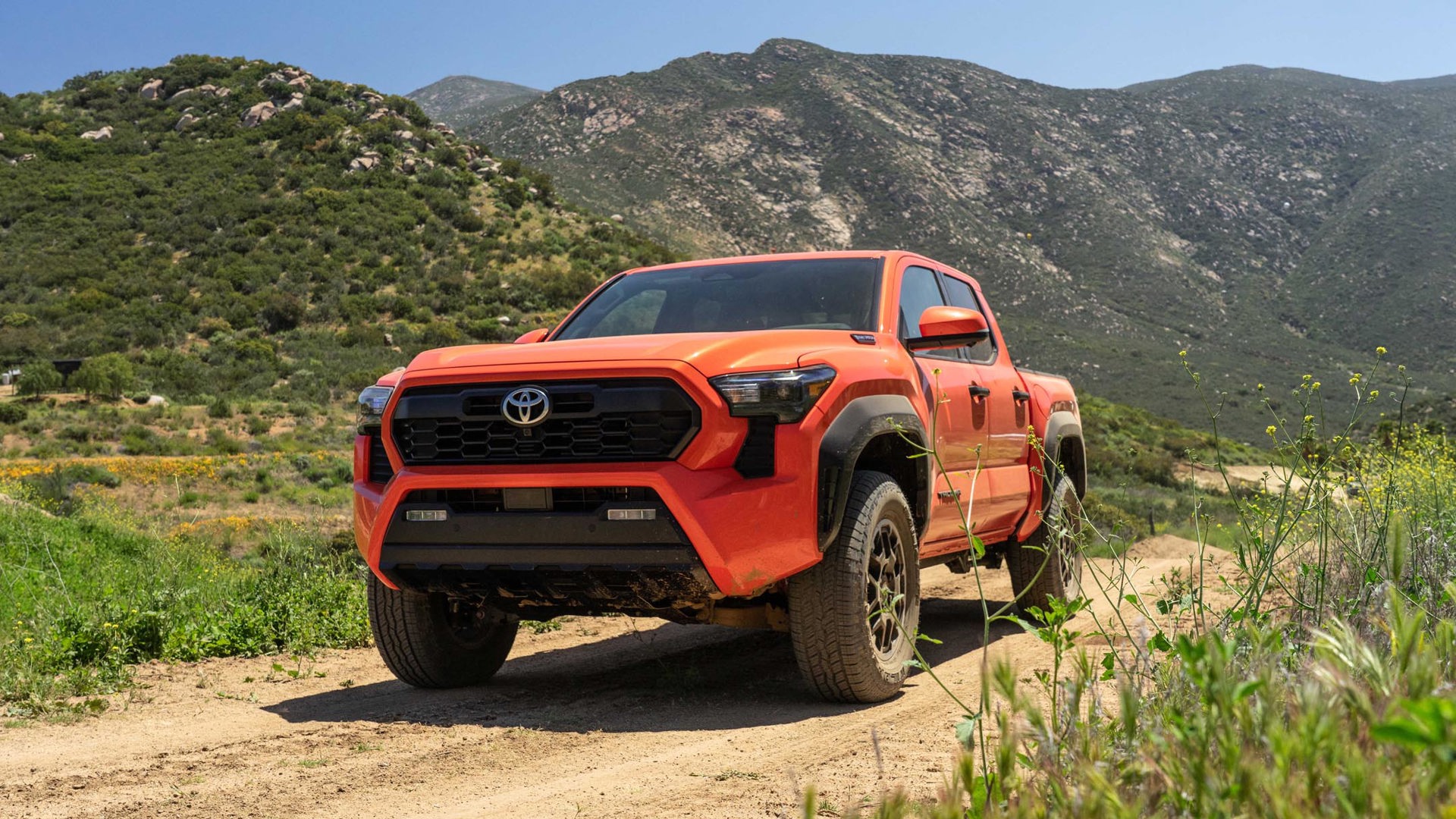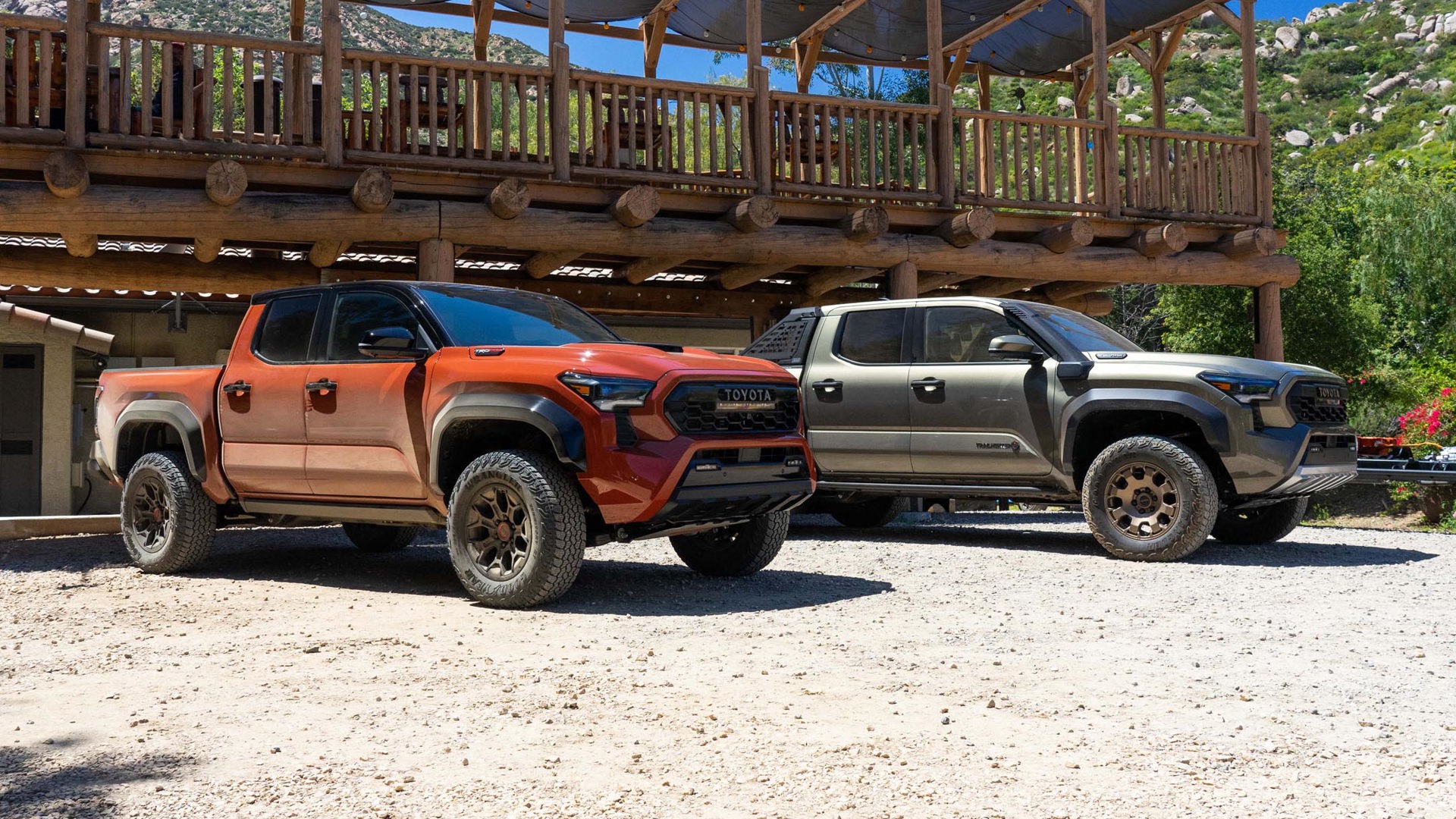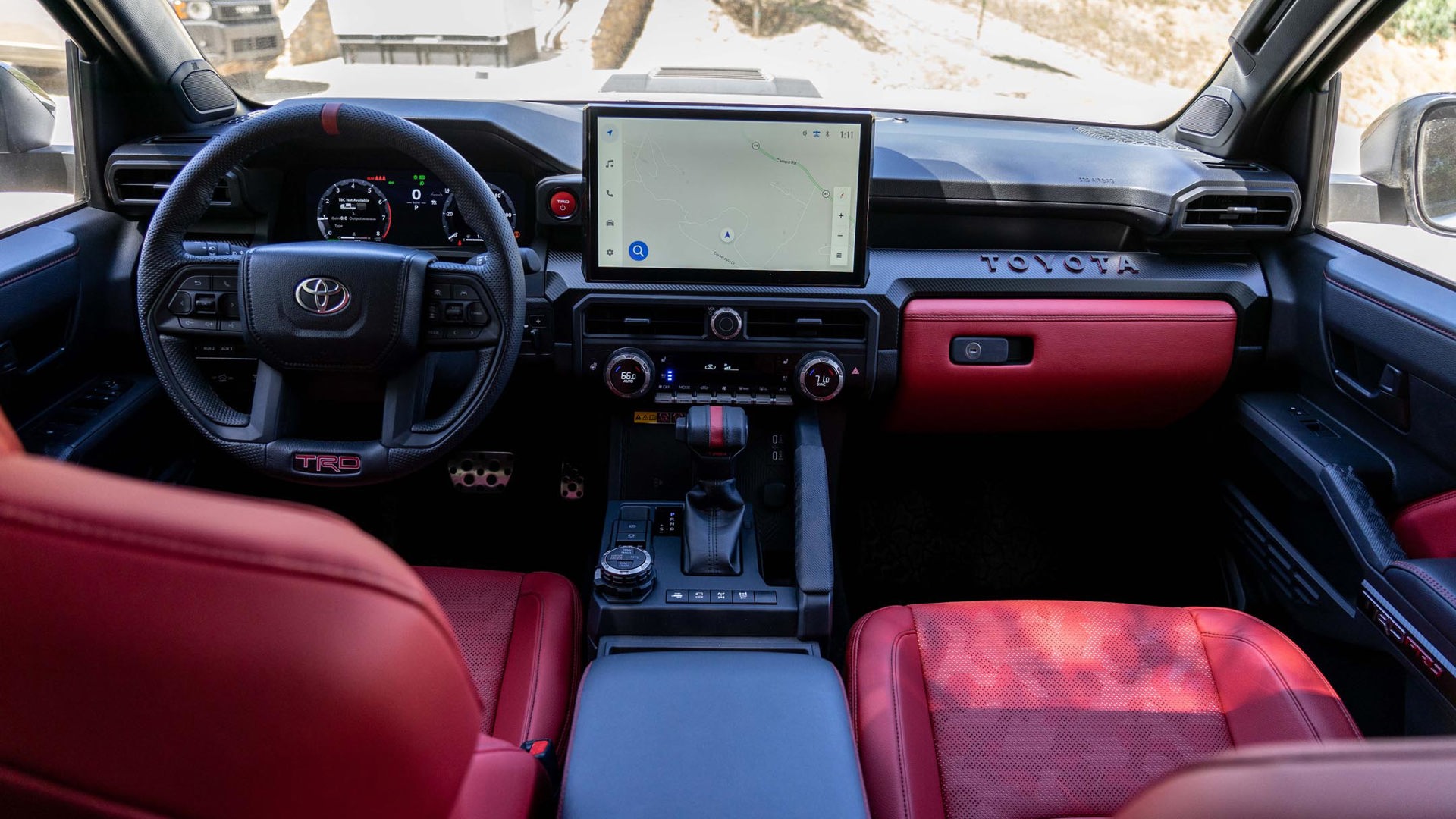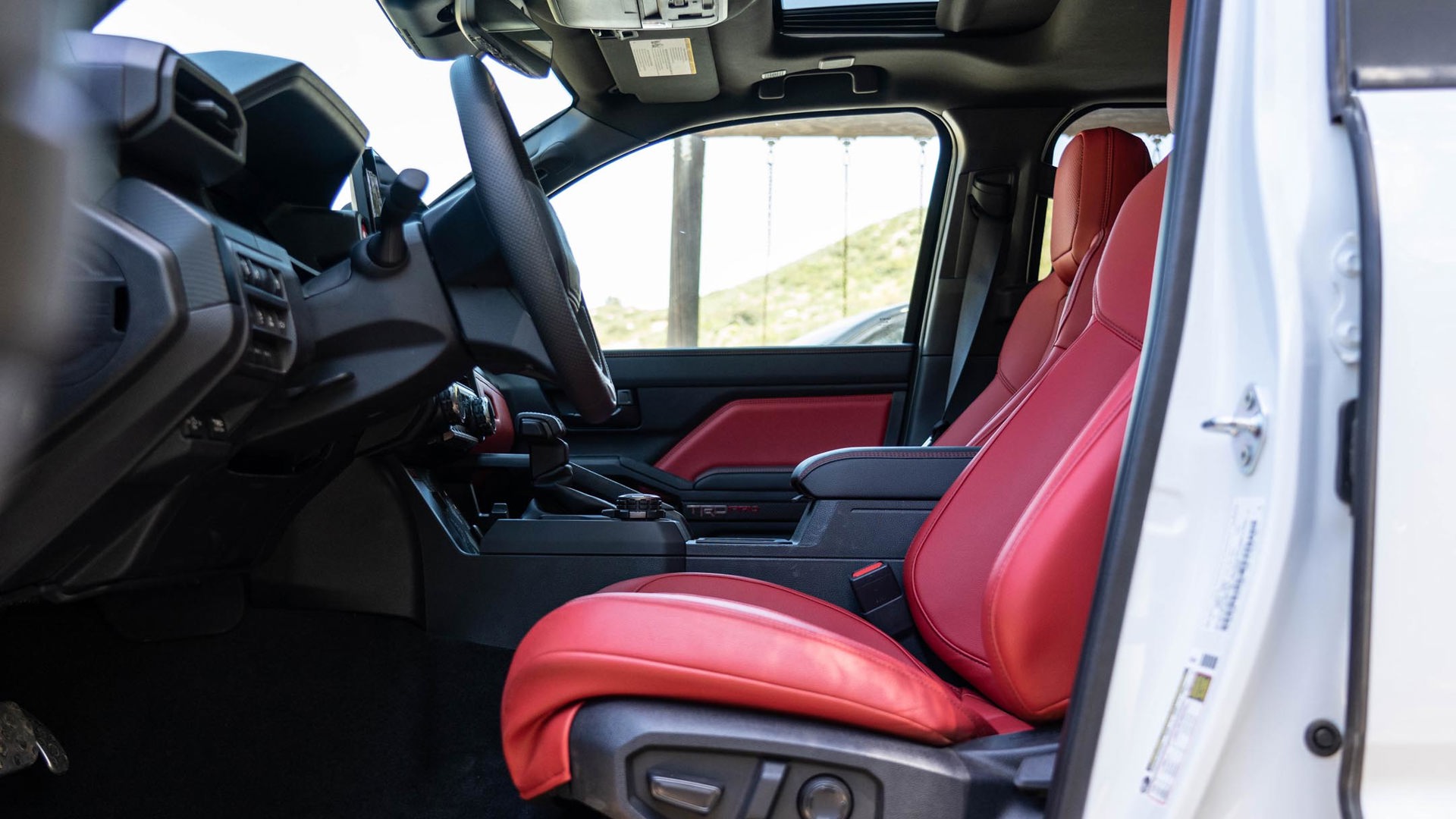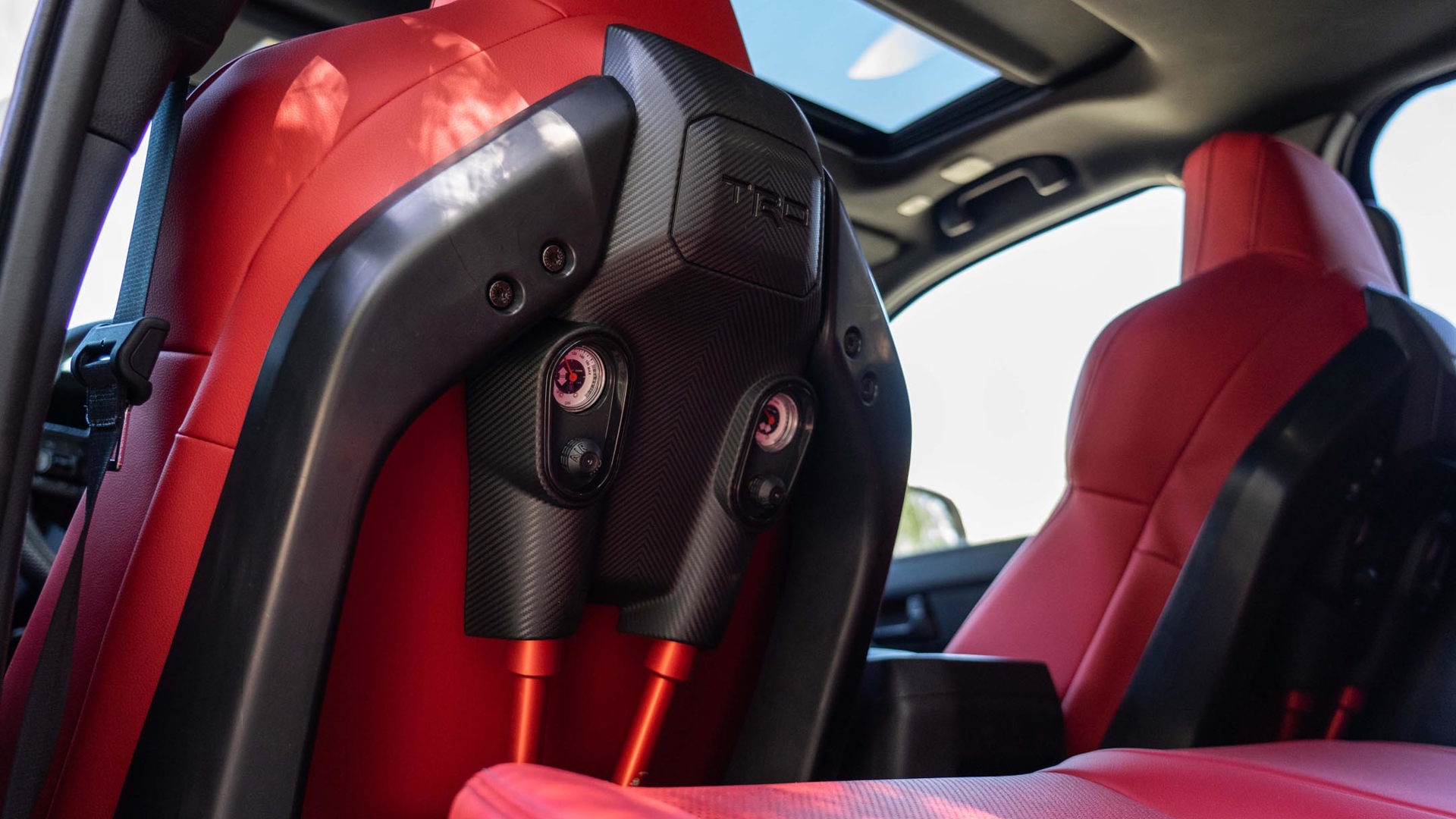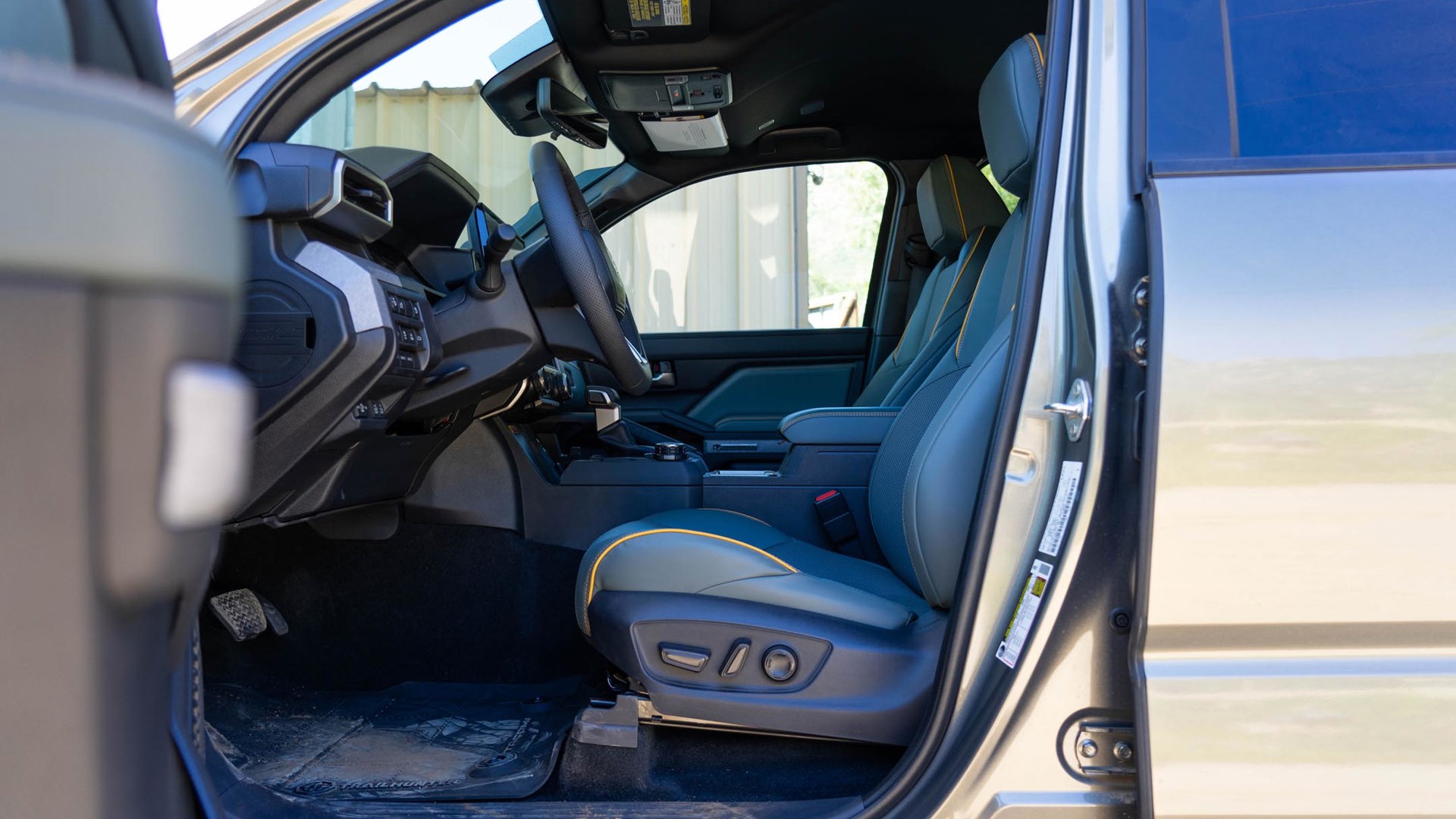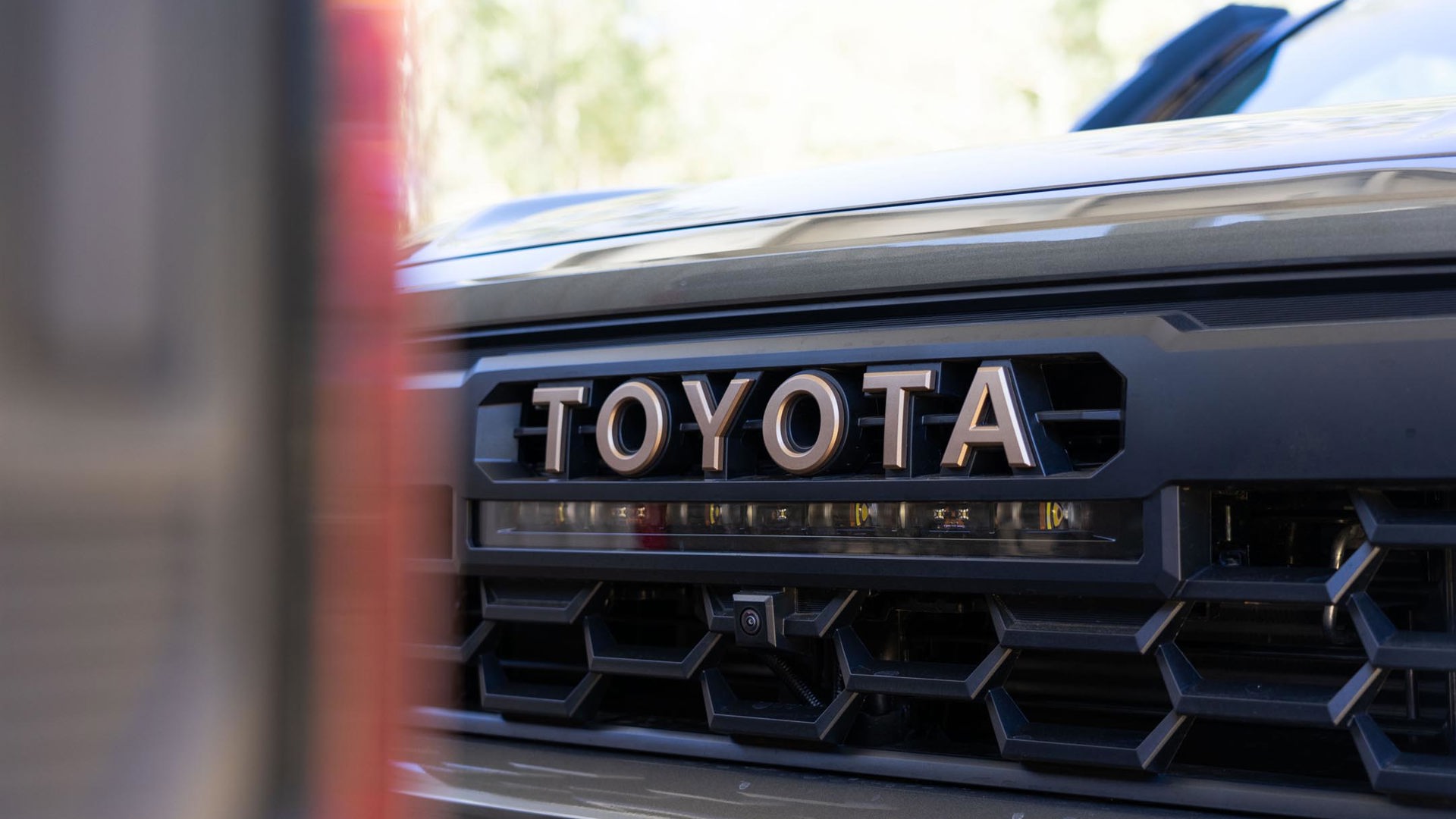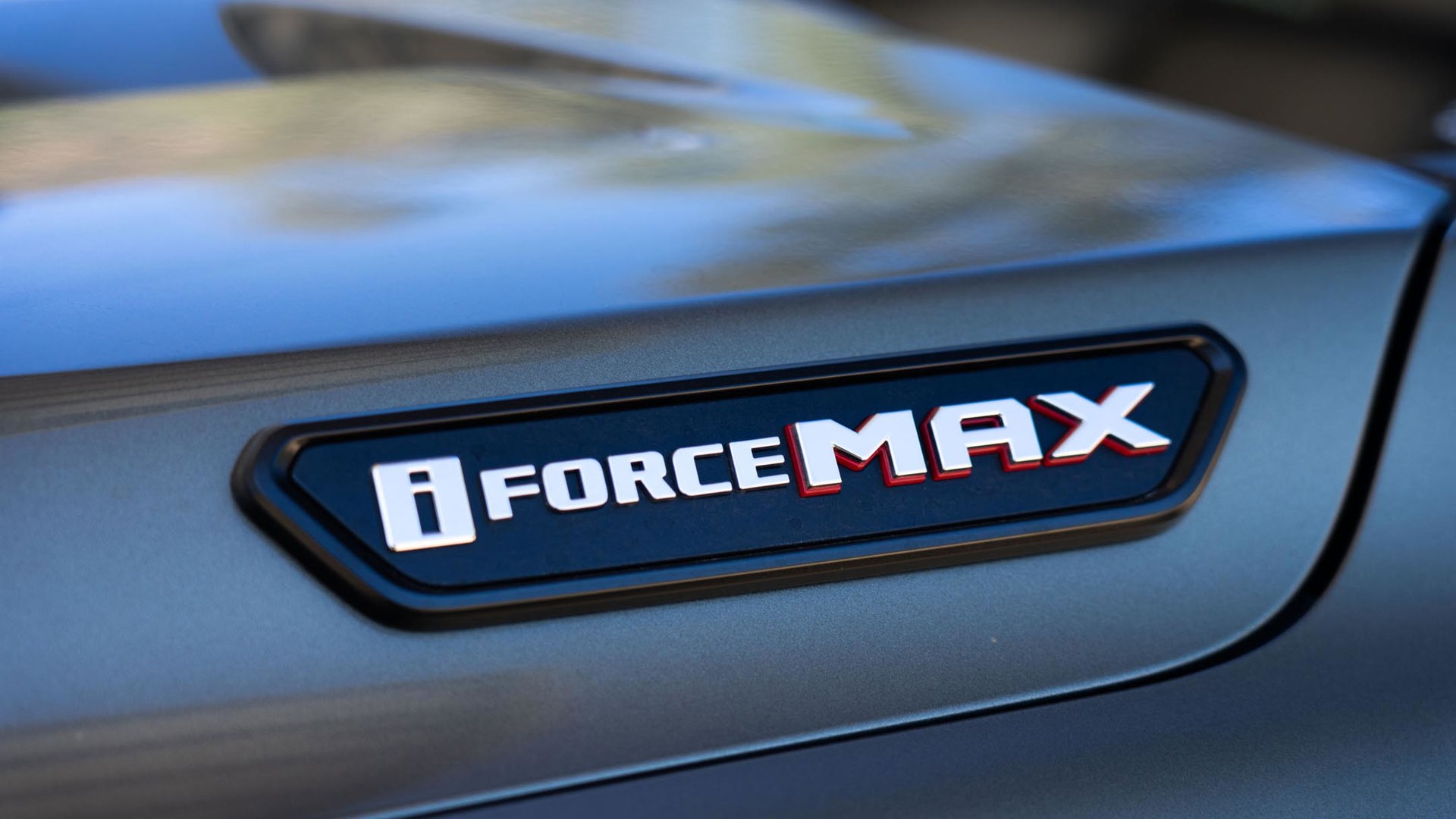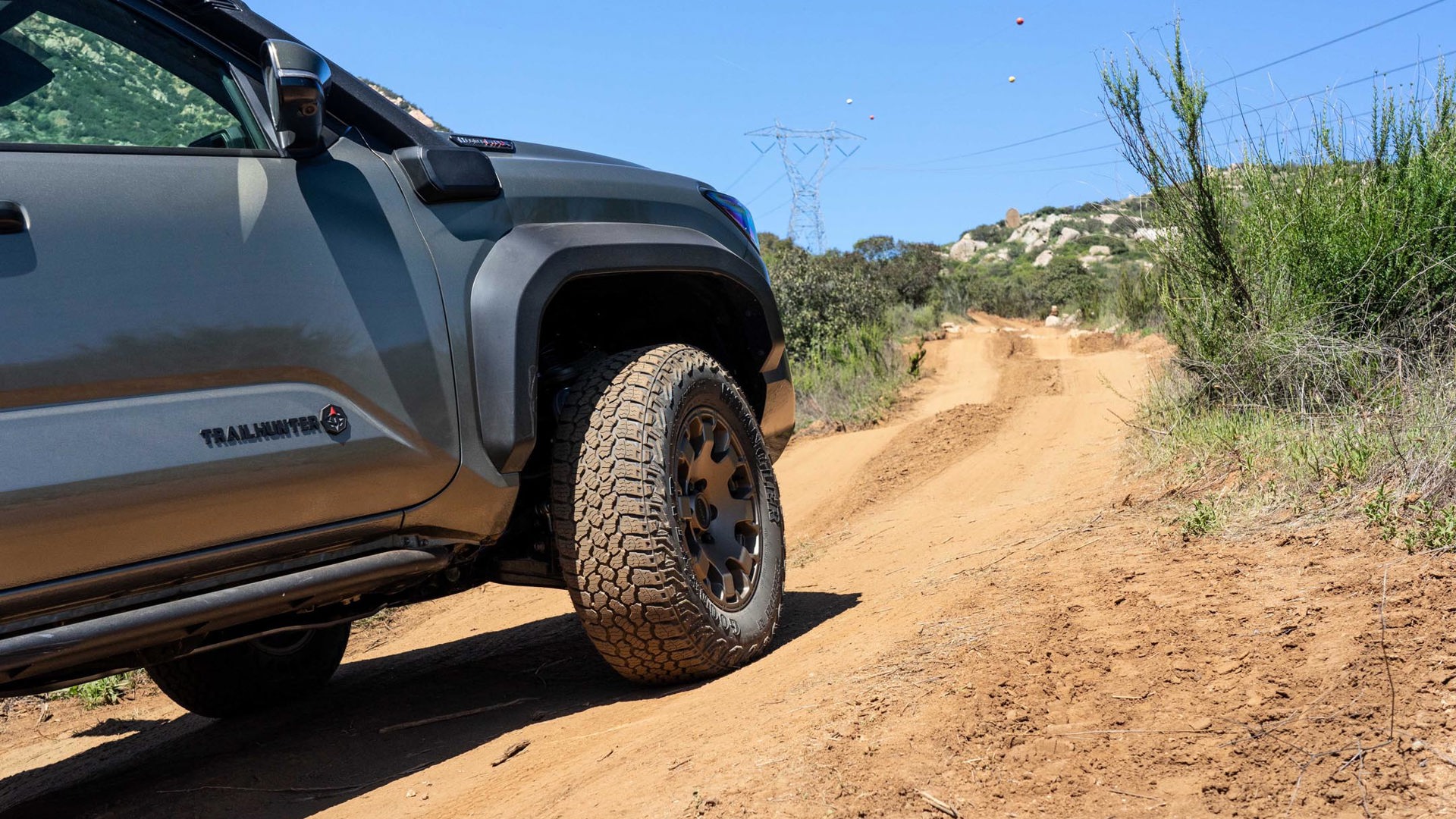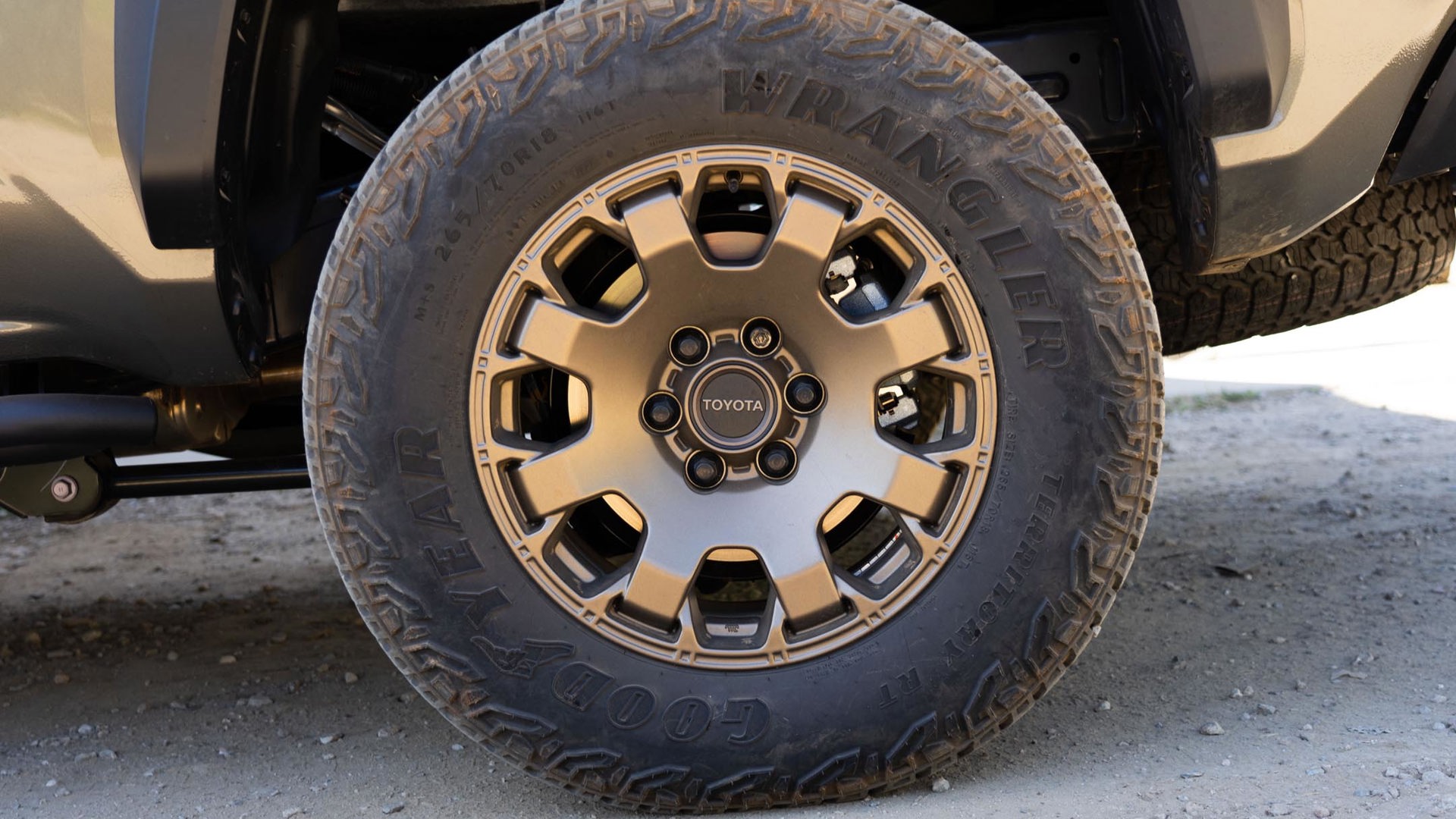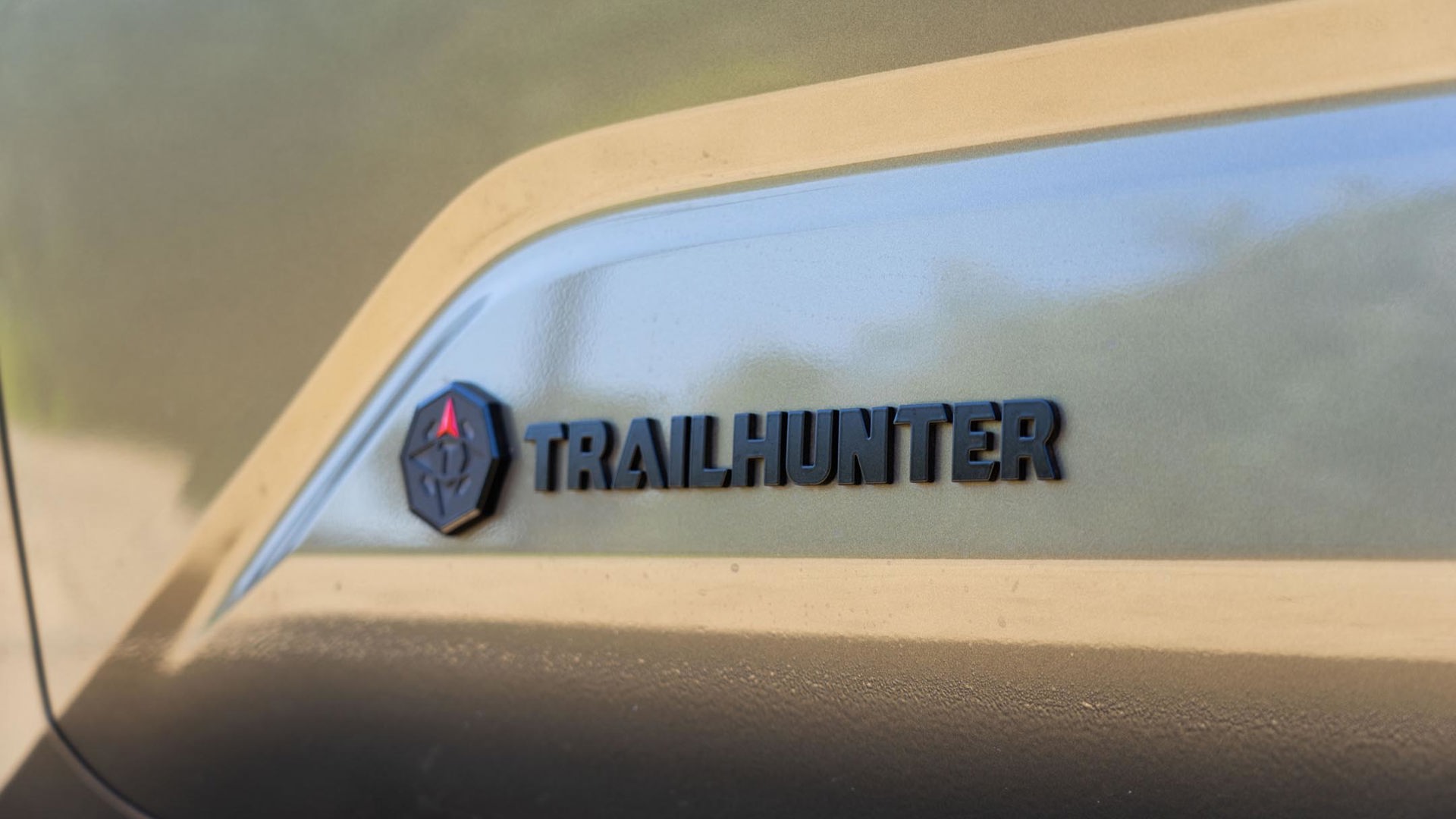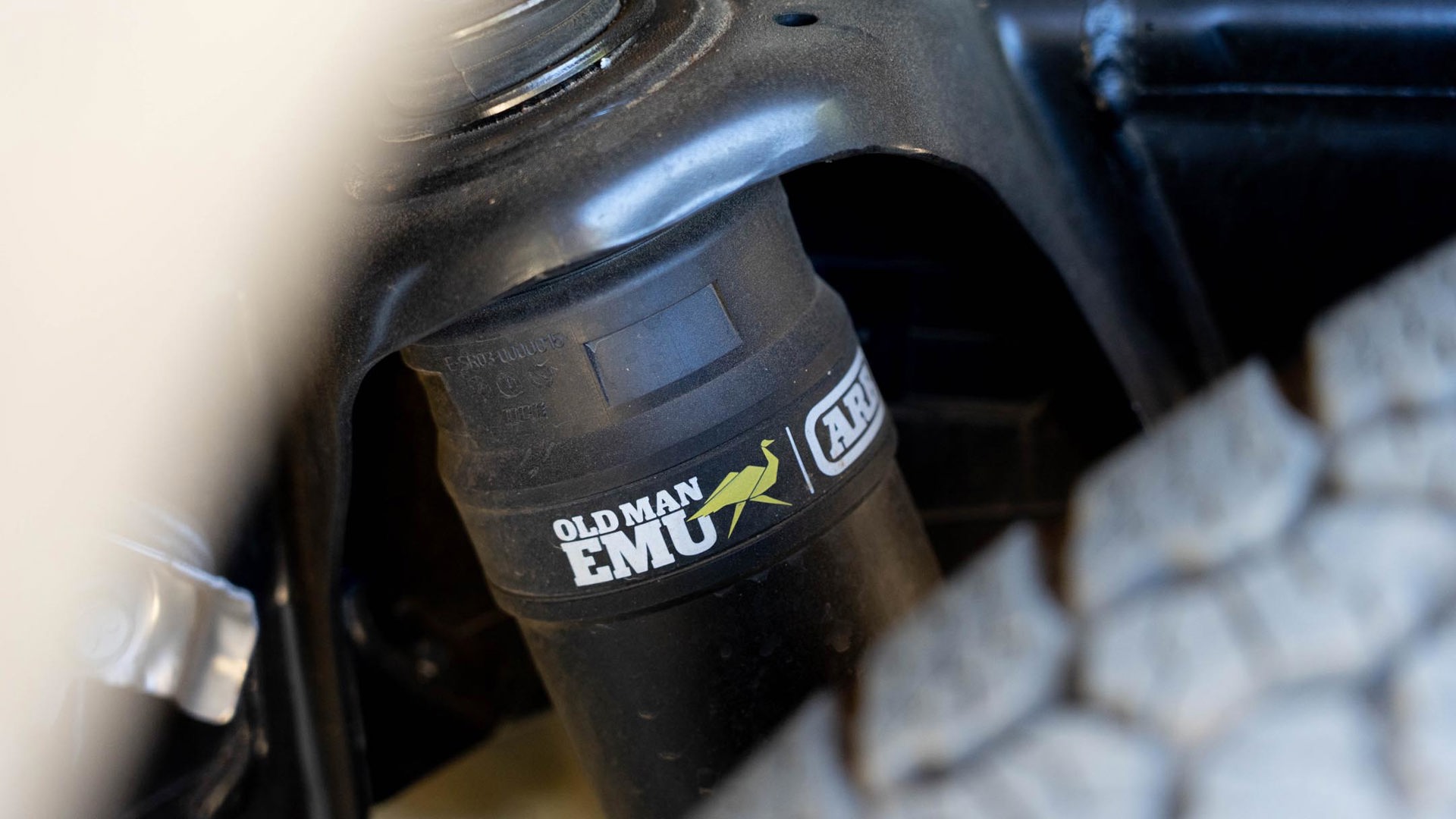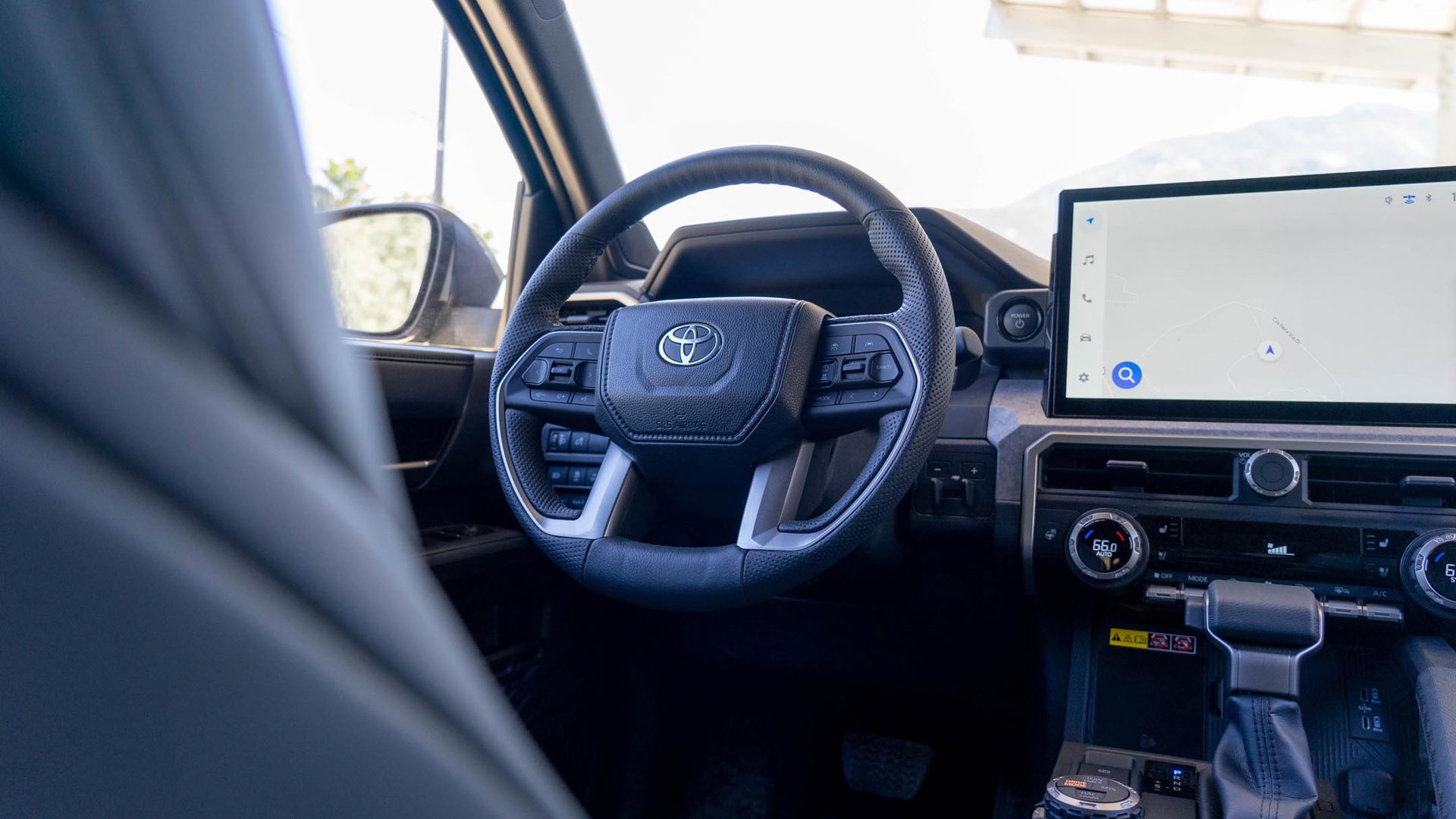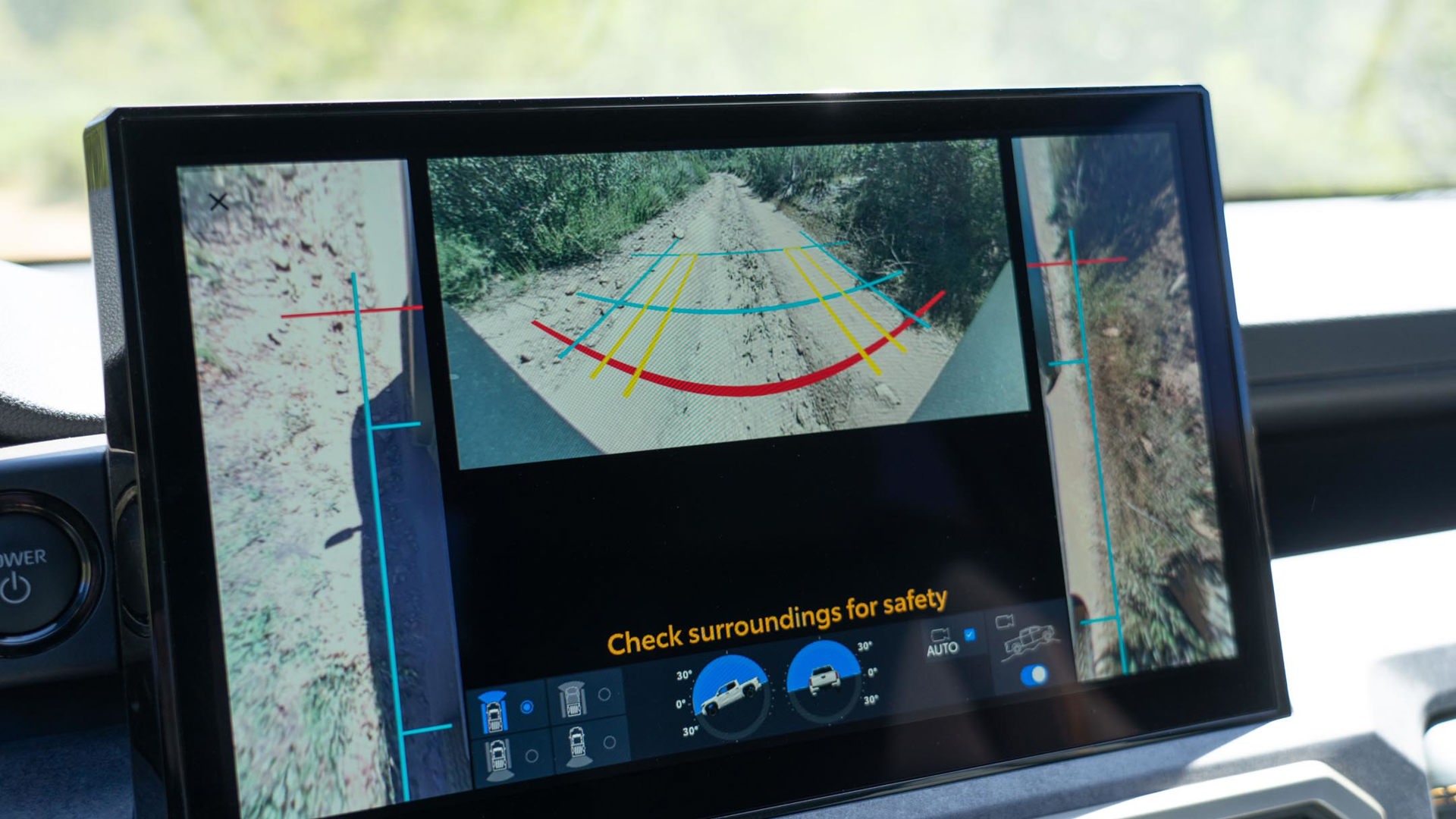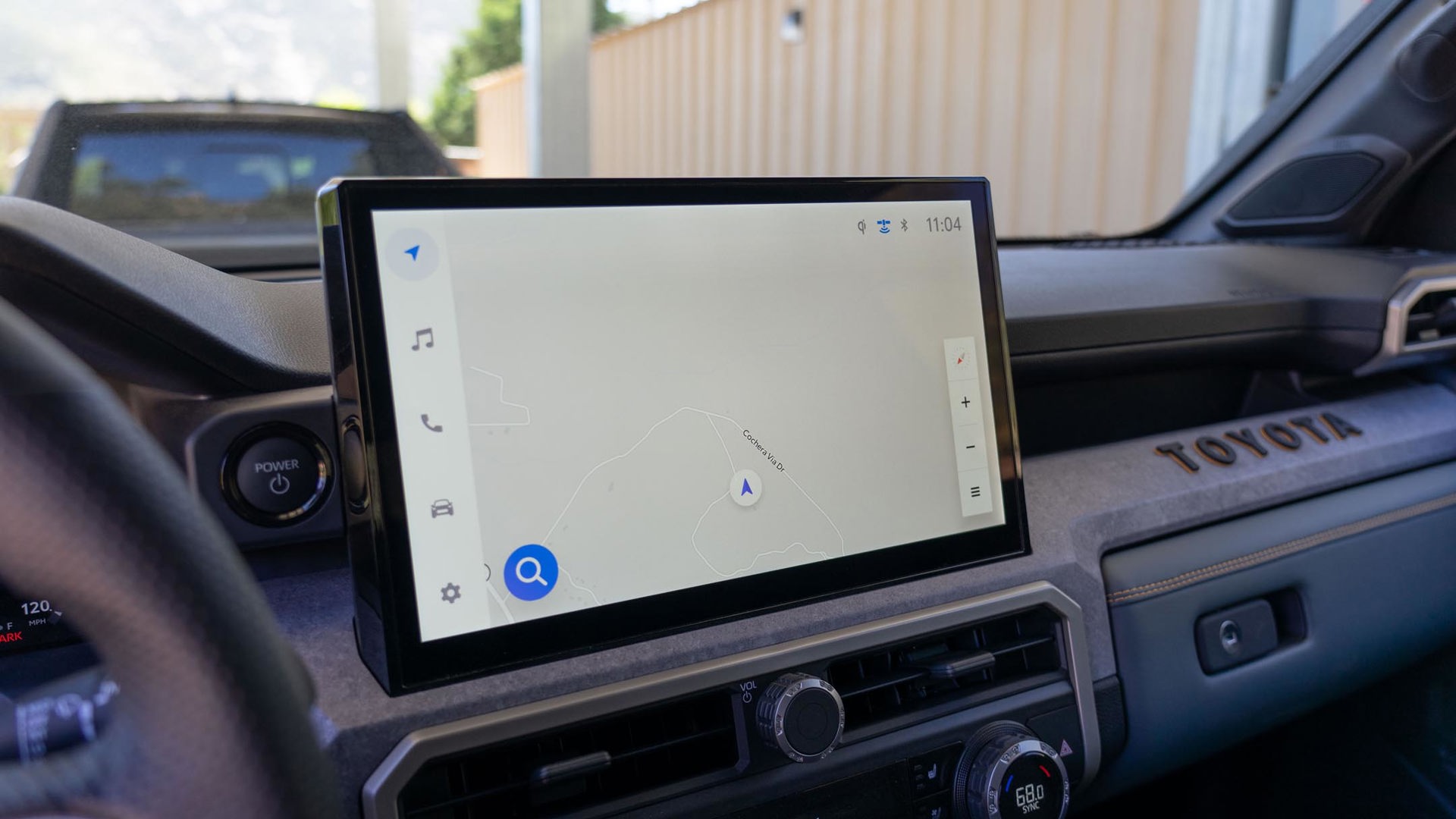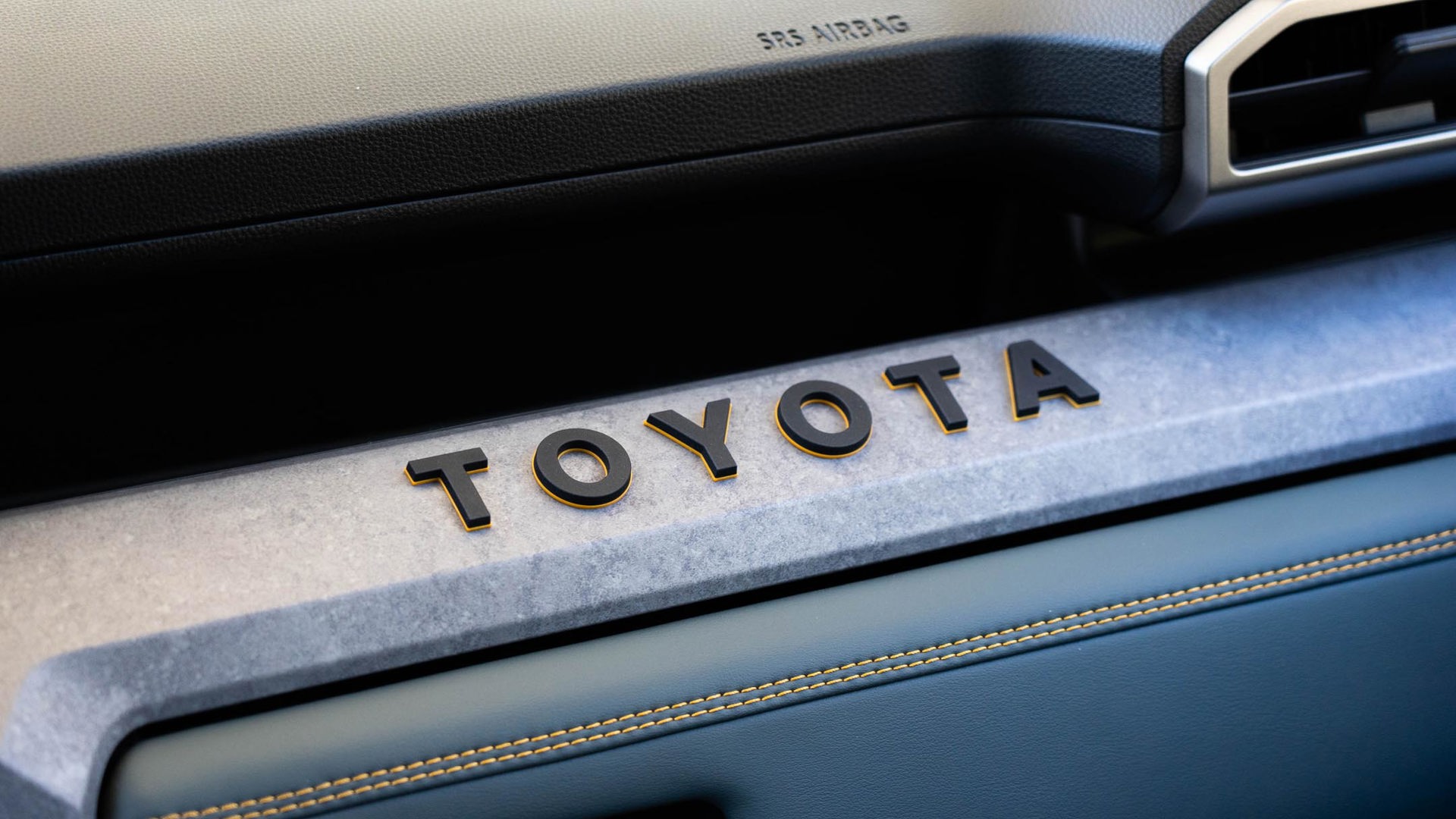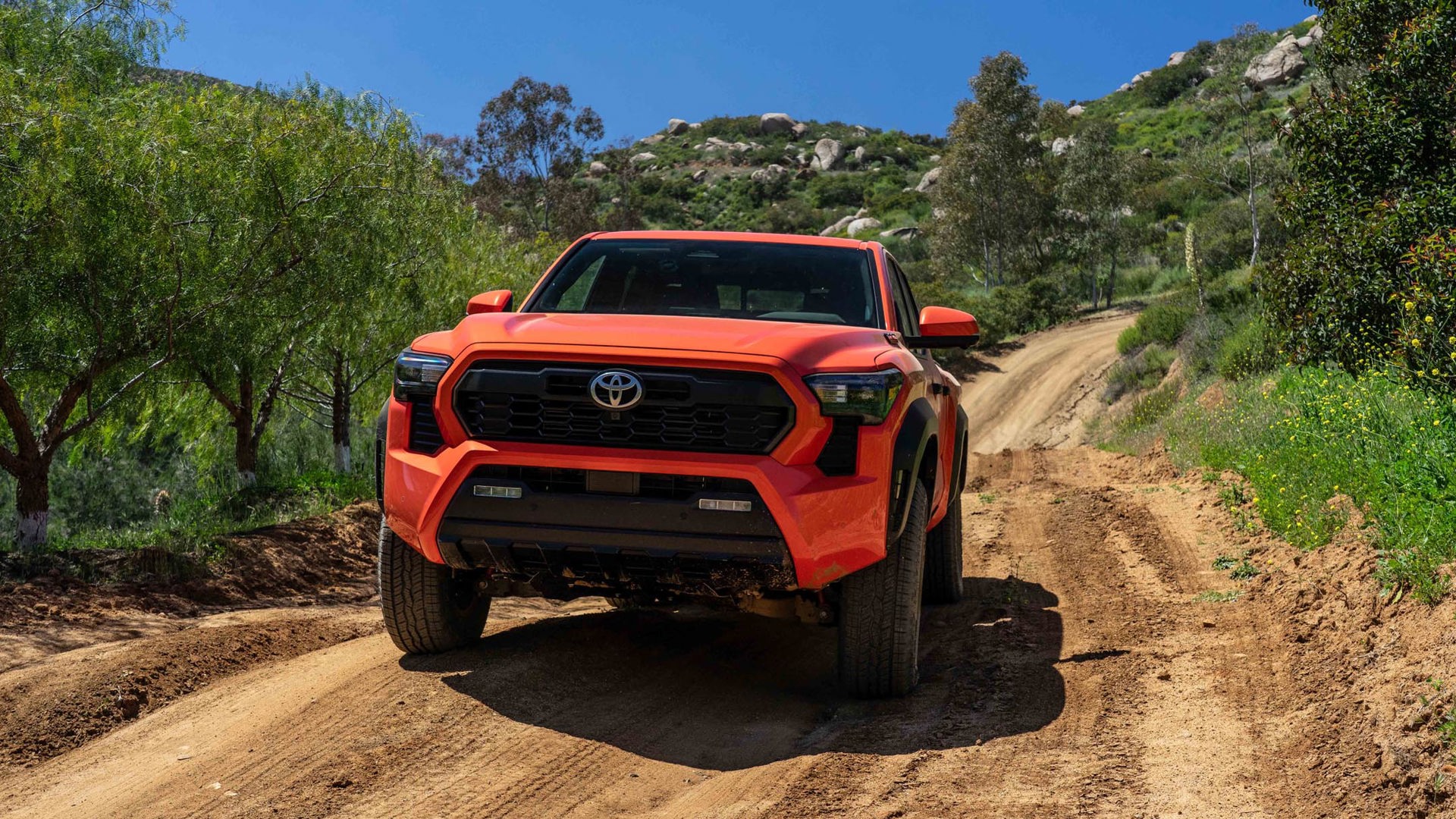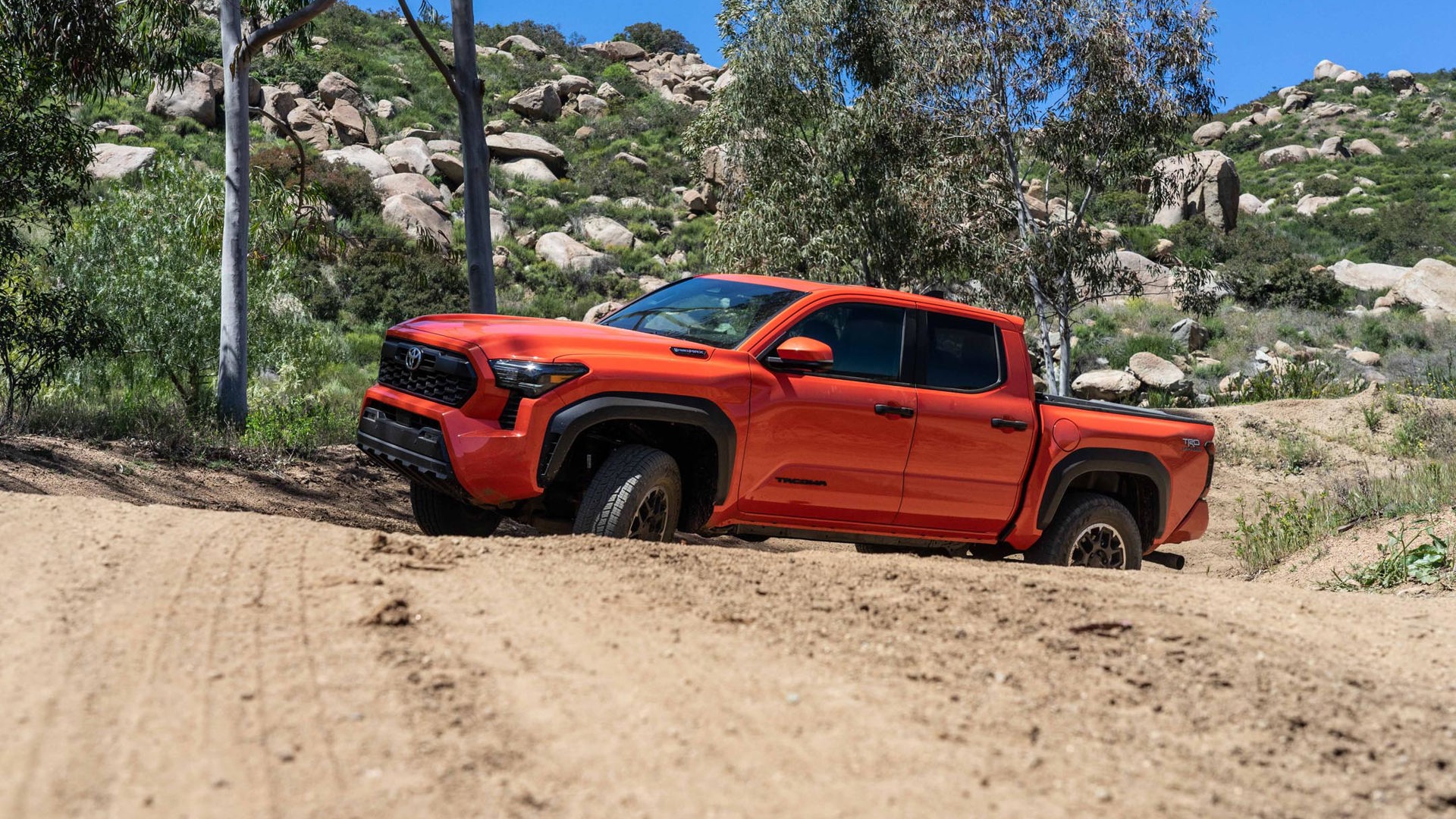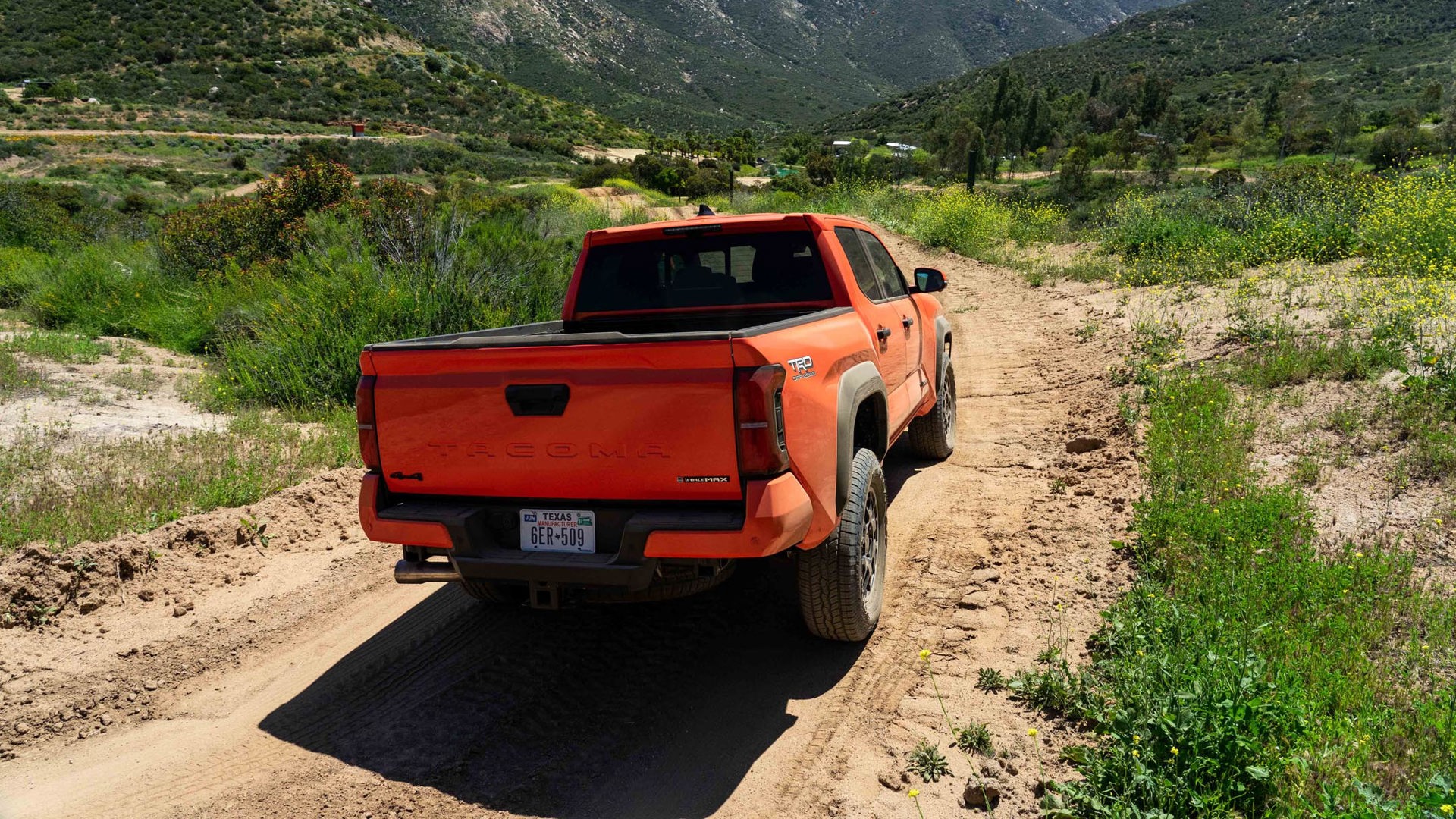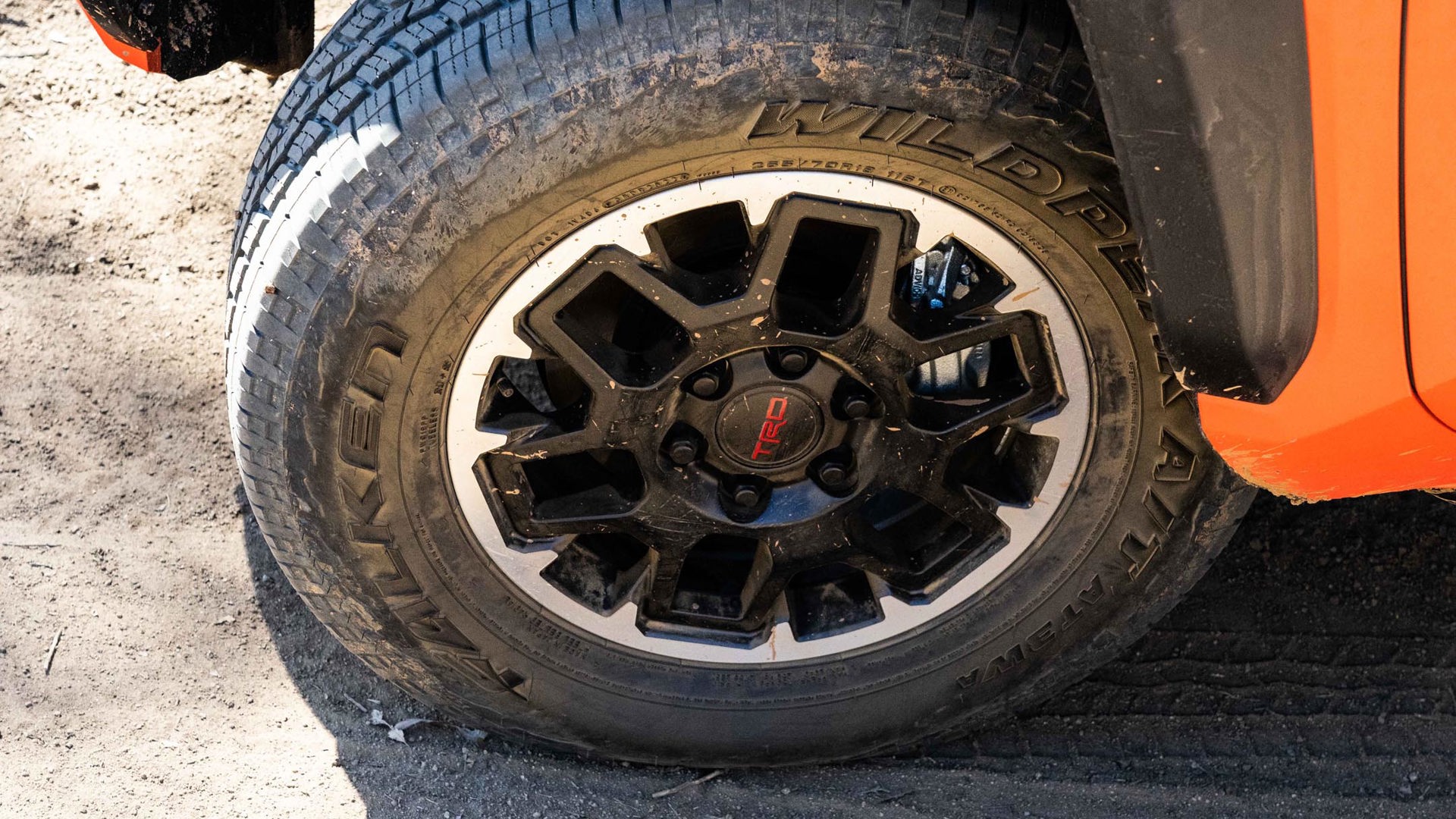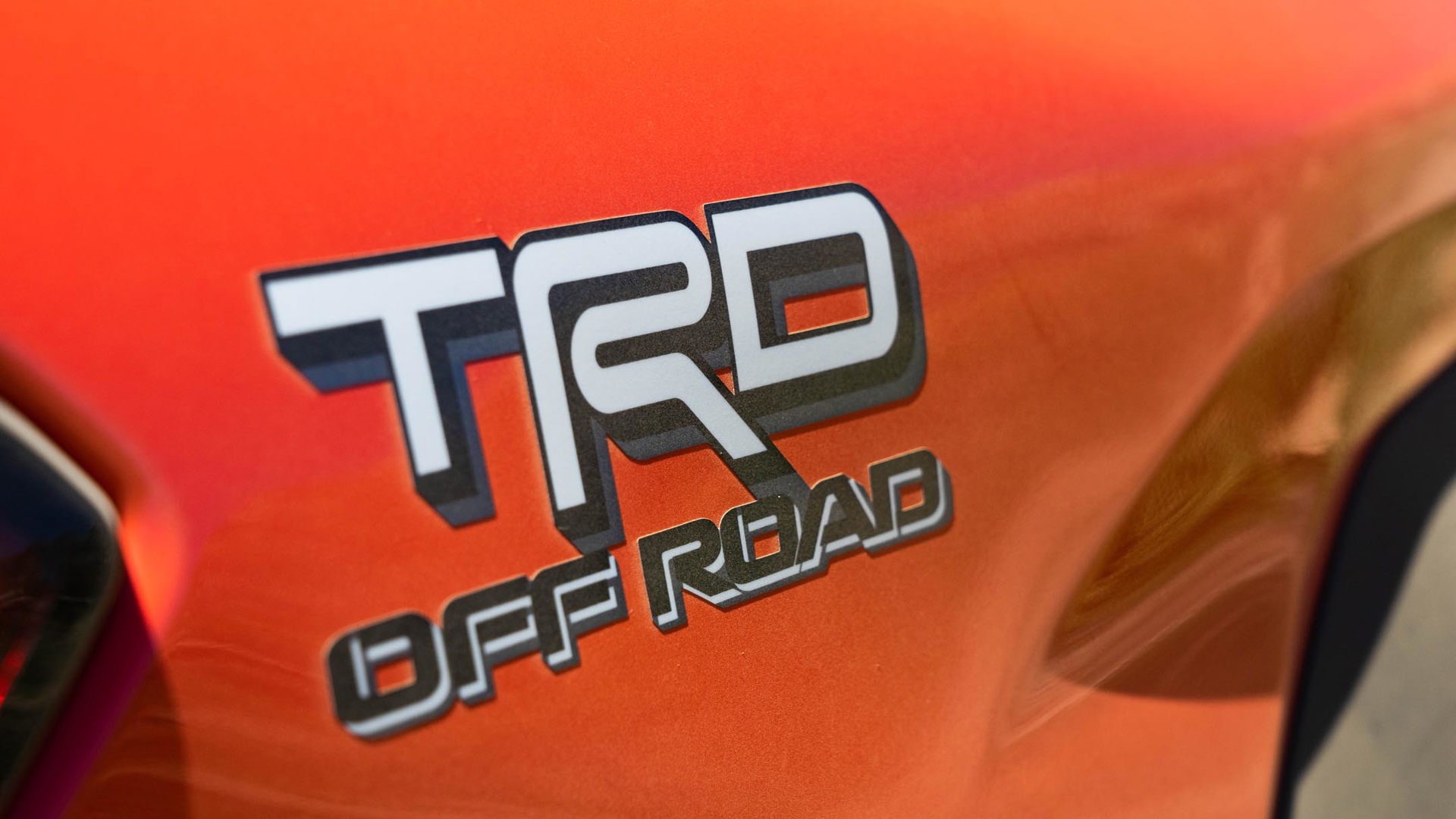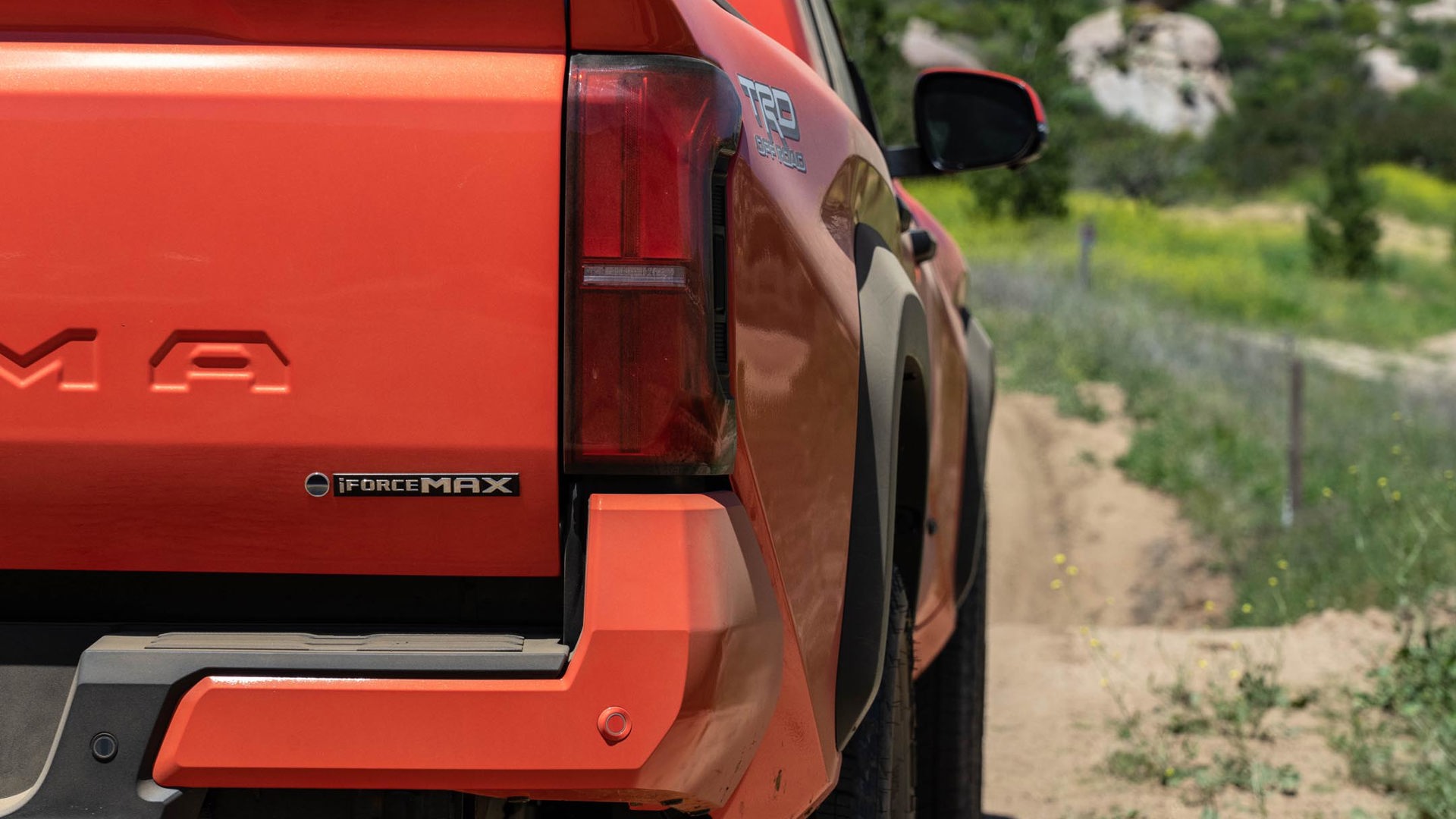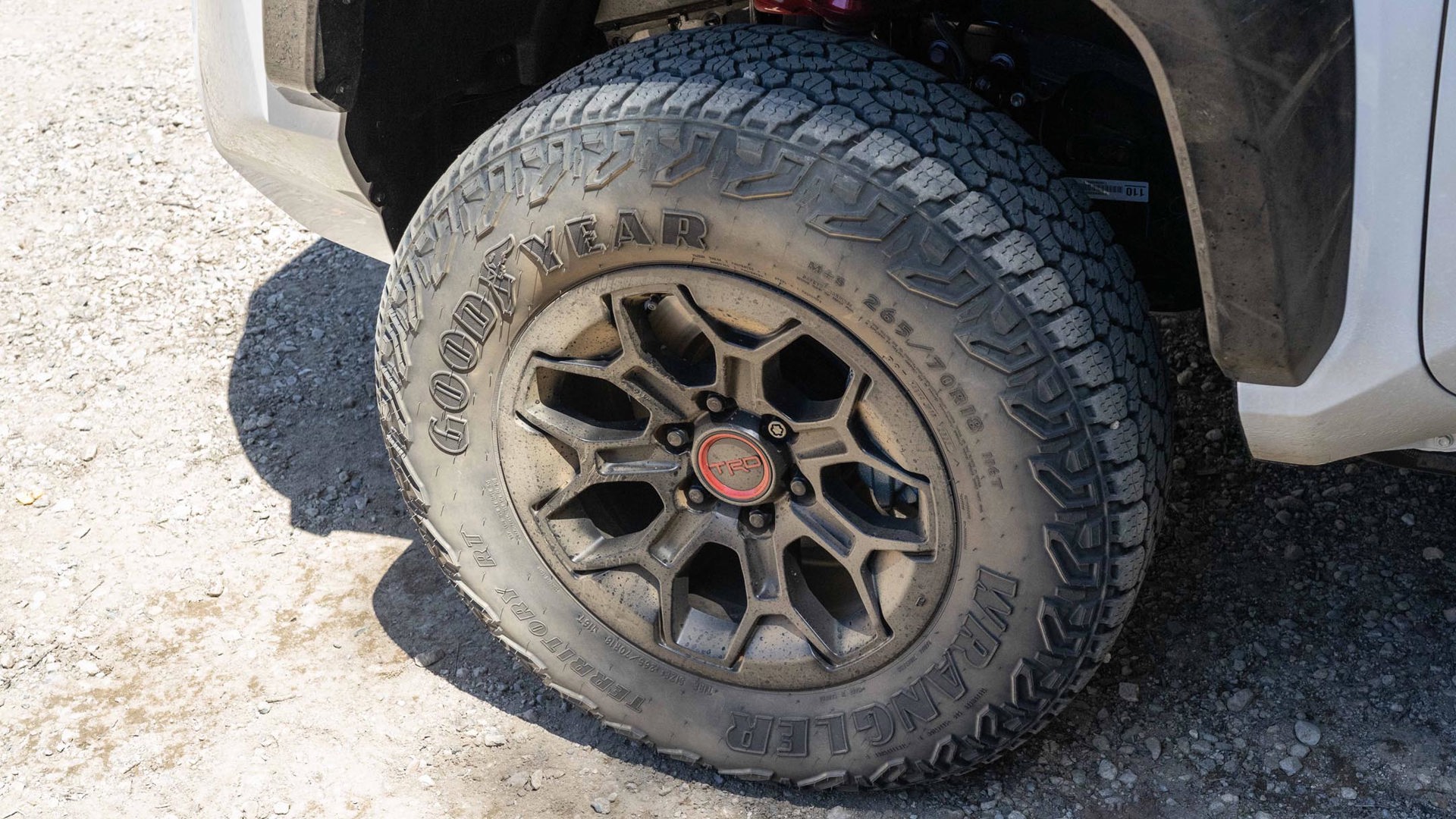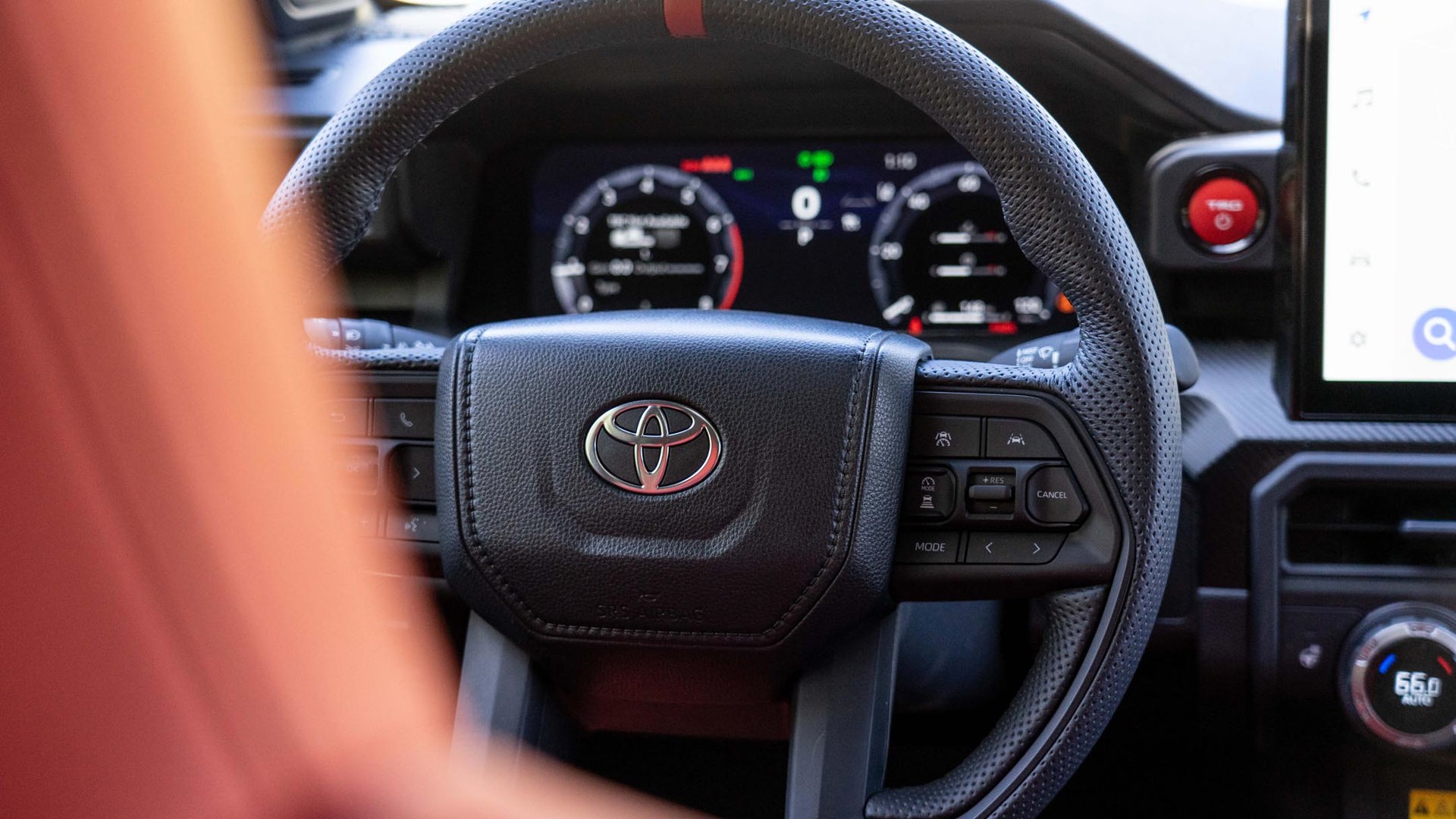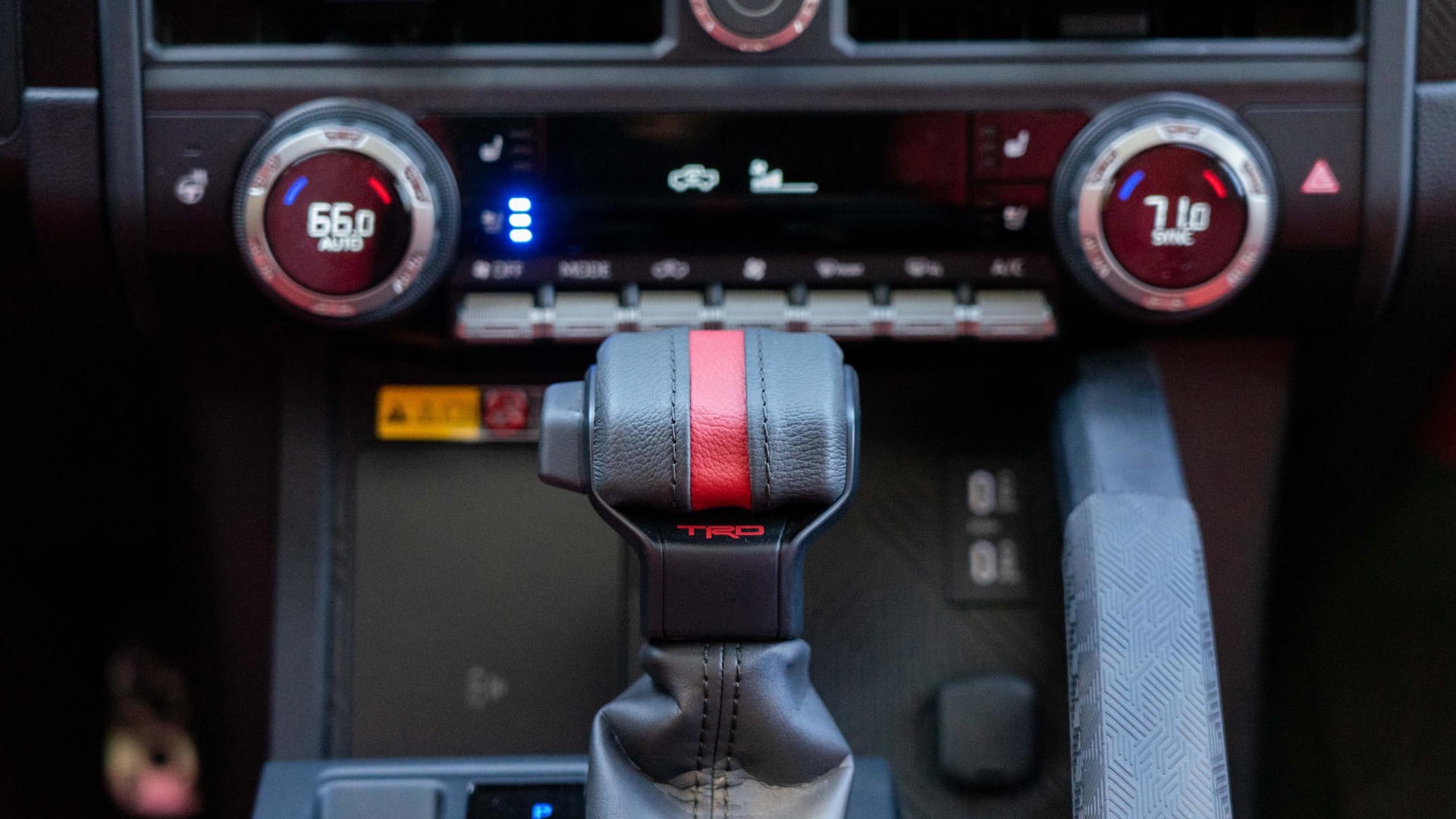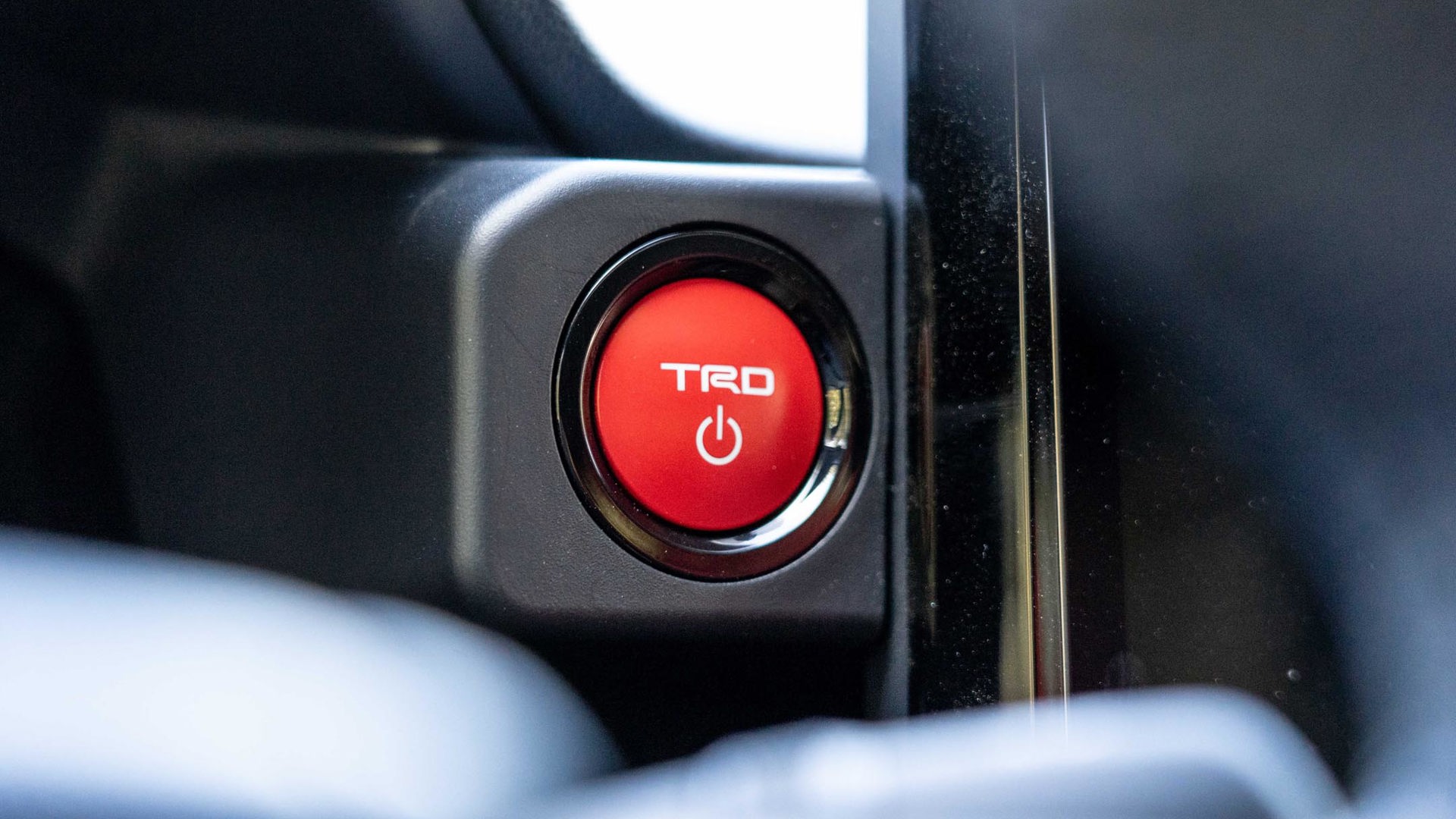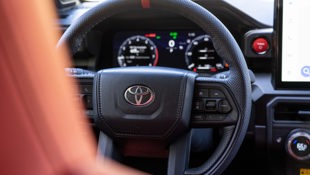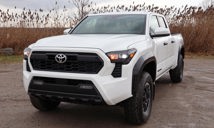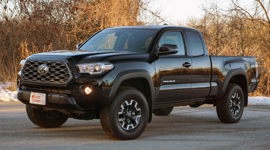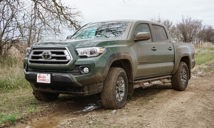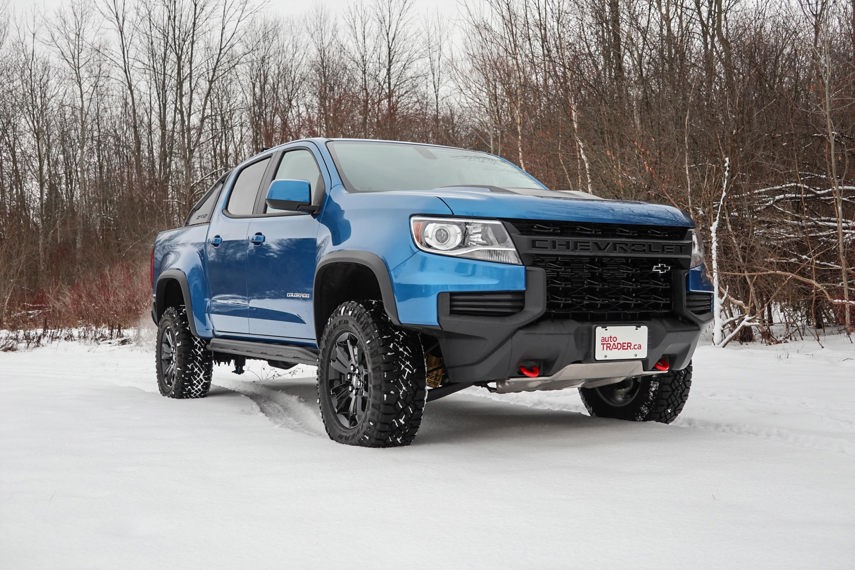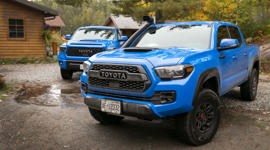Photos by Brendan McAleer, Toyota
Everybody loves Tacos. Canadians certainly do because the Toyota Tacoma outsells rivals like the Ford Ranger or Nissan Frontier four to one here. Part of the appeal is image, as sporty Toyota pickups have been burnished with the California lifestyle ever since Marty McFly changed history to get his lifted little black truck. However, Tacoma owners use their trucks as intended, perhaps even more so than people who buy full-size Fords and Rams. This is why we begin our story in the driver’s seat of a new hybridized Tacoma TRD Pro, soaring two feet above a gravel road south of San Diego.
No, Toyota has not invented the long-awaited flying car. But the Tacoma returns to earth with the gentlest of bounces, then proceeds to run up the potholed road at a sustained 70 km/h, floating over the surface while the suspension furiously works away. Some of that serenity can be credited to the complicated and expensive front seats here (more on those in a bit), but it’s really because the basic mechanics of the Tacoma are rock solid. If you want a Land Cruiser with a pickup bed, here you go.
As mentioned in a first drive of that Land Cruiser, the Tacoma is one of five new body-on-frame vehicles launched recently by Toyota: the redesigned 4Runner, Land Cruiser, Sequoia, and Tundra. And, if you’d like to lump in Lexus as well, then the GX too. The frames of each are of different length depending on specification, but it is not quite an oversimplification to say that the Tacoma benefits here from having the same spine as Toyota’s full-sized pickup offering.
Those benefits extend beyond just toughness for airborne hijinks. This all-new version of Toyota’s beloved pickup is better behaved on road, has better cabin ergonomics, and will probably live longer thanks to its boxed-in construction and some Toyota engineers’ obsession with preventing rust. It is also considerably more efficient with the new turbocharged and hybridized four-cylinder engine, and can be optioned up with parts that will make any Instagram-obsessed overland camper green with envy.
There’s really only one drawback to this new Tacoma, and it’s the same thing that’s been affecting actual tacos of late – inflating prices. Before we get to those somewhat painful figures, let’s see if we can achieve liftoff a few more times.
What if You Took a Prius Off Some Sweet Jumps?

While there will certainly be people who will miss the previous generation Tacoma’s 3.5L V6, be it resolved that only the soundtrack is lacking. The new 2.4L turbocharged engine whistles like a diesel under load (which is kind of fun), and, in this hybrid format, produces torque like one, too. On 87 octane fuel, Toyota says this engine will make a peak of 326 hp at 6,000 rpm and 465 lb-ft of torque from just 1,700 rpm. Towing capacity is 6,000 lb.
All hybrid Tacomas get an eight-speed automatic transmission with a proper low-range transfer case and selectable four-wheel drive. The nickel–metal hydride (NiMH) battery has a capacity of 1.87 kWh, and you can’t plug it in. The electric motor is a 48-hp unit that fits between the combustion engine and transmission like a slice of baloney in a sandwich. Toyota calls the whole mild-hybrid setup the i-Force Max, which is coincidentally the name of the gaming joystick sitting on my desk as I type this.
Toyota has been selling its hybrid technology in the form of the Prius to the likes of Leonardo di Caprio for long enough that ol’ Leo would probably break up with it (i.e. it’s more than 25 years old). There is no secret of NiMH; it is a fully understood and realized technology that isn’t quite as power-dense as lithium-ion technology but works well. There are millions of taxi cabs worldwide running Toyota’s hybrid systems, and every single one of them shrugs off abuse and mechanical neglect and just keeps on humming. Tacomas generally enjoy strong resale value, and this version should, too.
Fuel economy is rated at 10.5 L/100 km city, 9.9 L/100 km highway, or 10.3 L/100 km mixed. The Limited trim does slightly better, but that city mileage is within 10 per cent of what you get out of a RAV4 Trail, and 10 per cent better than a Ford Ranger with the 2.7L Ecoboost engine.
Power delivery is likewise excellent, with all that shove coming on quickly. There’s no turbo lag and it’s easy to modulate the throttle for slow-speed off-road crawling.
Ironman Ivan Stewart’s Super Offroad Arcade... Truck
(Don’t worry if you don’t get that reference. It’s an arcade and Nintendo game from 1989 featuring tiny jumping Toyotas.)
Toyota offers the Tacoma hybrid in four grades in Canada, all of them in double cab format, and all save one with the five-foot box. There’s enough cabin space here to work as the primary vehicle for a small family, and I can already picture these lined up at the local North Vancouver trailheads with $20,000 worth of downhill mountain bikes hanging over the back tailgates.
Sorry, Marty, this is not a truck for you. This is mom or dad’s truck, and the starting price reflects that. The most affordable Limited trim starts at $63,390, or there’s the TRD Offroad Premium for $64,850. Either one of these trims is how you want your Tacoma served, with the latter being slightly more oriented to tarmac driving. Both feature tech essentials like a 14-inch touchscreen with wireless Apple CarPlay and Android Auto, niceties like heated and cooled seats (heated steering wheel, too), and camping-friendly extras like a 2,400W AC outlet. The Limited gets a power tailgate and power running boards, and the TRD Premium gets a locking rear diff and push-button disconnecting front sway bar.
On a less technical but still challenging offroad section, the TRD Premium was all the Taco required. No, there was no high-speed jumping, but the TRD Premium was essentially as capable as the Land Cruiser when driven back to back, offering more equipment at a lower price along with pickup truck flexibility. Anything else you might want to add to this truck, the aftermarket will happily sell you.
With the possible exception of the seats in the TRD Pro, that is. Each of these wild-looking thrones features four pressurized shock absorbers that damp vertical, side-to-side, and fore-and-aft jostling. Hopping back and forth between the TRD Premium (which doesn’t get them) and the Pro proved two things. One: they work surprisingly well. Two: they are very silly.
For the latter, please set your front seat to the preferred ergonomics, then climb into the rear of the TRD Pro, upon which you will experience what it is like to have a professional mountain biker ram into your shins. Toyota made the Tacoma’s rear seats roomier this year, but these off-road-specific seats eat it all up. If you carry rear seat passengers, let alone ferry them down a bumpy road, the Pro is not for you.
But wait. Don’t climb out of the Pro just yet, as you’ll want to be in a shock-absorbing seat when I tell you how much the top-spec Tacoma costs. The TRD Pro is a stunning $12,100 jump over the TRD Premium, but the new, top-of-the-range Trailhunter has an MRSP of $82,950. That’s nearly twice the price of the base model non-hybrid Tacoma SR5.
Overlander Pockets are the Deepest

The Trailhunter is the only Canadian Tacoma hybrid you can get with a six-foot box, and that is because it is specifically aimed at the overlanding crowd. Overlanding, in case you don’t know, is a bit like camping, except in camping, you toast marshmallows with your kids over a weekend, and in overlanding, you drive to Antarctica for 10 months.
If you haven’t already guessed, it’s the sort of activity that was dreamed up by Australians and involves spending a fortune on specialized gear to go live a thousand kilometres away from the nearest flush toilet. Still, you can easily see the appeal of the Trailhunter, which gets rock rails and skid plates, model-specific alloy wheels, and remote reservoir shocks from Old Man Emu, an Australian off-road specialist.
Crawling through the most technical of three off-road courses showed how capable the Trailhunter could be. Despite being the longest of the four new Tacomas, it was just as surefooted as the smaller Land Cruiser had been, with Toyota’s updated crawl control off-road cruise setting particularly impressive. If you want to really get into the backcountry, the Trailhunter will take you there.
And frankly, for the price, it’s probably better positioned than the other $80,000 midsize pickup out there, the Ranger Raptor. Buyers considering the Trailhunter wouldn’t even dream of buying anything other than a Tacoma. They are Toyota loyalists and could easily swing a well-equipped full-size pickup, but they want to own the best version of some slightly ratty SR5 they drove in university. Now they’ve sold off their start-up biotech company and can afford to.
Final Thoughts
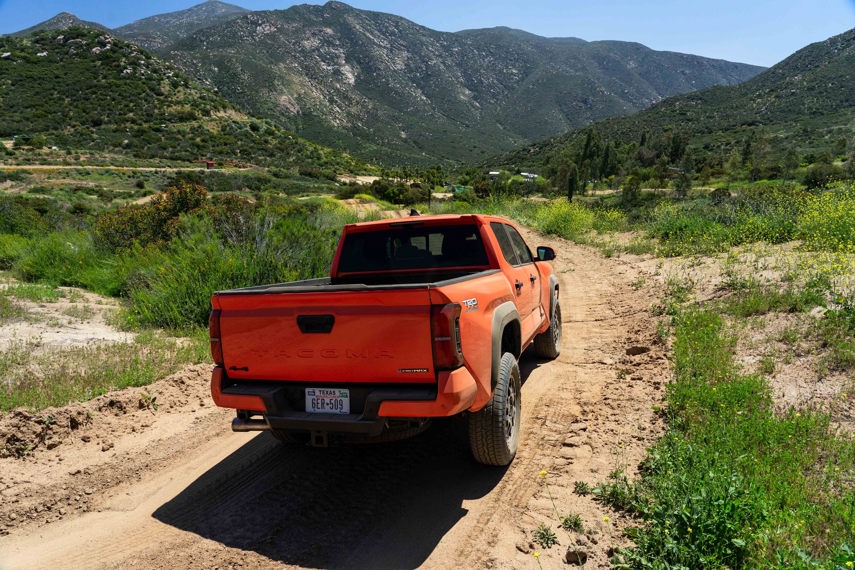
The flying 2024 Toyota Tacoma TRD Pro seems likewise a pretty expensive halo product, so perfected for taking to the air that Waylon Jennings should voice the navigation directions. Just like the Trailhunter, Toyota fans are going to drool over the Pro and spend hours on the online configurator. On the plus side, their old Tacoma will likely fetch a significant chunk of its original price tag.
For everyone else, the TRD Premium or Limited Tacomas are the two that make the most sense. Both are more expensive than even the old TRD Pro model, but given the improved fuel economy, ergonomics, and better on road performance, both are still a solid choice. Also, both should give you a clear hint to what the 4Runner is going to drive like and what its price points are going to be. An $80K+ 4Runner Trailhunter is almost a surety.
Want to spend less? Then $46,950 will get you a non-hybrid SR5, or you can even get a manual-transmission Tacoma for under $50K. With fuel prices being what they are, the extra power and fuel economy of the hybrid makes a great deal of sense if you’re looking at a better-optioned Tacoma.
Compared to the simple old original Toyota pickups of the past, the new Tacoma is a much more complex and expensive machine. By expanding the range into a much higher price level, Toyota is testing just how much its biggest fans are willing to spend. It’s probably a safe bet, though. Because everybody loves Tacos.
